( Log In ) Log In is for TREC Teachers & Researchers only
  |
| Steve_Marshall |
 Jul 3 2005, 01:59 AM Jul 3 2005, 01:59 AM
Post
#1
|
 TREC Teacher    Group: TREC Team Posts: 78 Joined: 27-April 05 Member No.: 12 |
Monday, June 27
Added Bonus: Self-tour of Barrow, Part I—The Iñupiat Heritage Center There are only two commercial flights out of Barrow; One in the morning around 10:30, and the other in the evening at (supposedly) 7:50. While most of the group was flying out on the evening flight, several also flew out this morning. This was something I totally missed since I didn’t wake up until 11:00. I guess my body was beginning its recuperation from many nights of little sleep. I kind of regretted not being able to say goodbye to the friends I had come to know over the past few weeks, but it also felt so good to just sleep. Anyway, once my body did decide it could halfway function, I got up and met up with some others who weren’t leaving until the evening flight to go into town. Our first stop was the Iñupiat Heritage Center, which is a museum that serves as a means of describing the way of life of the Iñupiats, who are the indigenous people of the North Slope of Alaska. We were lucky enough to get to the center just as a demonstration of native dance and culture was being conducted. Seeing the various dances made me think back to the TREC teachers’ orientation meeting in April. Watching the almost flawless dancing made me laugh again at ourselves when we had tried to do a similar dance with much less coordination on our parts. I learned my lesson and made sure to hide myself very well behind the camera when this group had also asked for volunteers to participate The Iñupiat Heritage Center 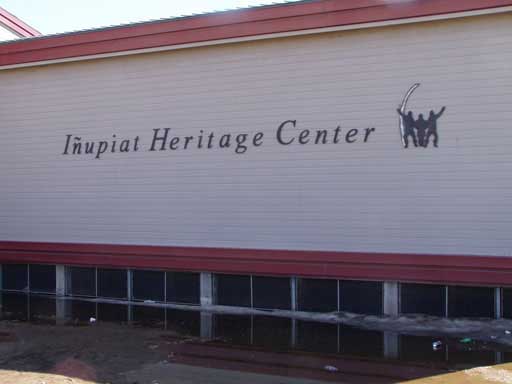 This is next to the front entrance of the heritage center, just to let you know you’re in the right place Jaw Bones 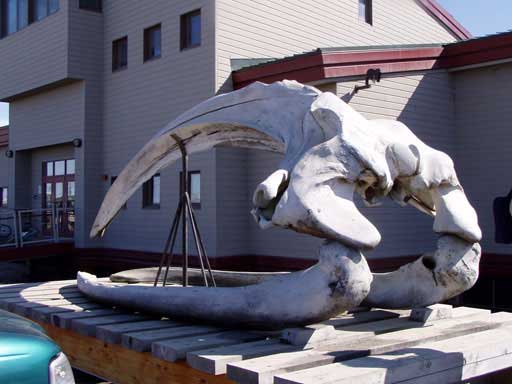 Because whalebones are so common, this is a familiar sight in front of many buildings. This is a set of Bowhead Whale jawbones in front of the heritage center Showing How It’s Done  A picture of the Iñupiat group during a native dance. A much better job than I had done at the orientation meeting in April! Comfy Carrier  A woman demonstrates how babies are lifted and then carried on their backs to keep them warm (and out of the way In addition to the dancing, the group described other aspects of the culture such as how babies are carried while the mother does work or other activities, the different games that are played, and the always-favorite blanket toss. It seems like a lot of people already knew about the blanket toss, but it was the first I had heard of it. It’s where a group of people hold the edge of a blanket, which actually seems more like some type of animal skin than what I think of as a blanket, and tosses a person up in the air. There is a funny aside to this: I don’t know if it’s just that my experience has made my mind tune in to things about the arctic more, but it seems like there has been a lot of things about the arctic on TV both before and after my trip. An even stranger coincidence was that when I had returned home, I saw a program that talked about what else, but the blanket toss! What was interesting was that the program explained that the blanket toss, while most think of it as a fun activity, actually has a practical purpose. As you may have noticed in my pictures of the ice, sea-ice is relatively flat with the exception of a few pressure ridges. The absence of any tall features makes it difficult for whalers to see very far when they are looking for whales or trying to guard against polar bears. One way around this was to use the blanket toss to get people high enough in the air to look out around the area. I would guess you’d have to look pretty fast though since you don’t stay in the air very long! That also might explain, though, why the adults are tossed so high…The higher you get tossed, the longer you have to look. Don’t Let Go! 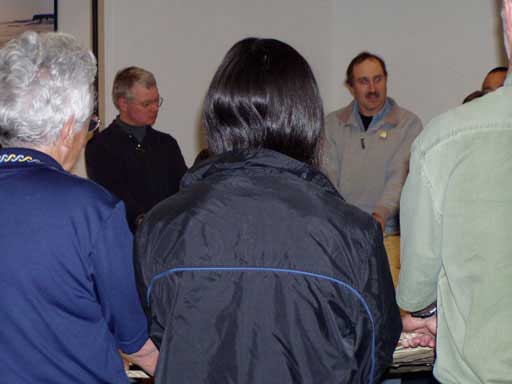 One of our group, Louis Whitcomb (left, facing camera), holds on tight in preparation for his part in tossing a few trusting souls high into the air One…  Tossee number one midway to the ceiling. Notice that in each of these pictures, Louis does a good job of keeping close watch on the position of the person being tossed. Two…. 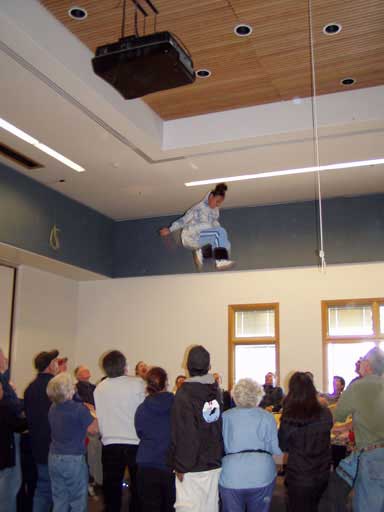 Tossee number two showing some moves Three!!  This was the last person to be tossed, and the only one to make it high enough to touch the ceiling…Mission accomplished! Anyway, back to the heritage center: After the demonstration and blanket toss were completed, we took time to look around the rest of the museum. There were interesting whalebone carvings, descriptions of the different North Slope towns, and other exhibits illustrating the clothing and way-of-life of the Iñupiat. Some of those exhibits are shown in the pictures that follow: Sculptures 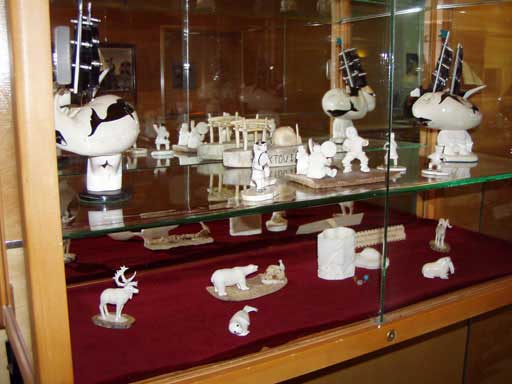 At first I thought these were ivory carvings, but a closer look (and wondering where the ivory would come from) made me think these were actually made from whale bones. Either way, these native works of art were very nice Close Up  This view, especially the texture of the boat, is what made me think these were mostly bone carvings. Realizing this was from Kaktovik now had even more significance since that was the location of the bear attacks the day before. Self-Description  This was one of many signs placed throughout the exhibits to describe the Iñupiat people and their way of life Universal Values 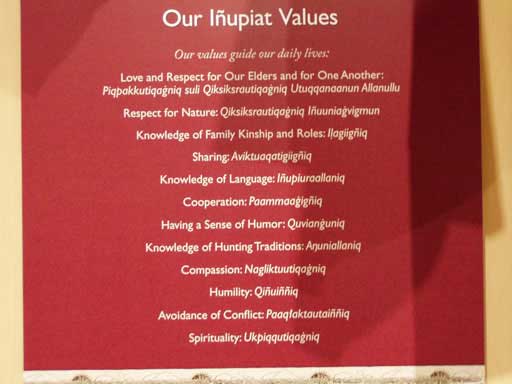 Another sign describing the Iñupiat values and the corresponding spelling in the Iñupiat language. While some are unique to this culture, it’s interesting to see how many are shared by most cultures Whaling Camp Gear 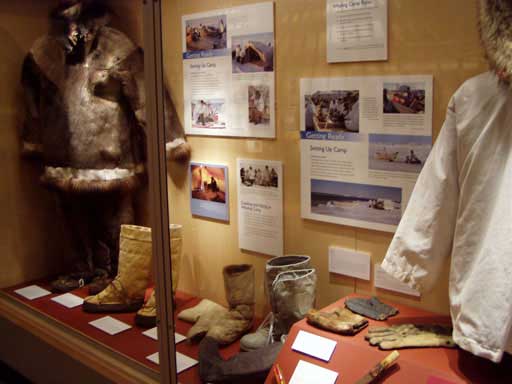 This was one of many displays showing the types of clothes and other gear used in whaling camps Looks Pretty Warm! 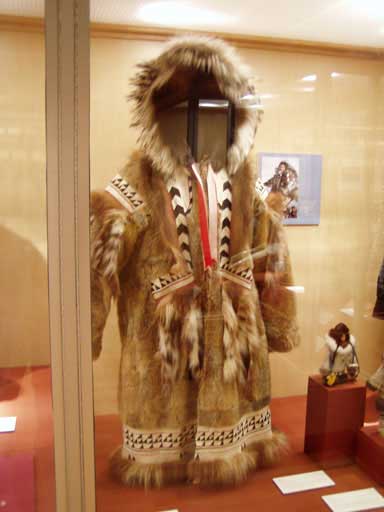 One of the things that stood out was how elaborate some of the coats were. I wondered if the types of coats and what they were made out of had any meaning such as status or group Tools of the Trade  This was just one example of the many harpoons and spears on display that were used for whaling Picture of a Picture  While it may not be that clear, I thought taking a picture of a picture showing how a whale is processed once caught was interesting Another Second-hand Picture 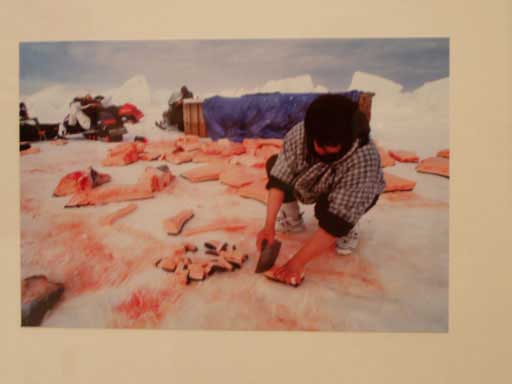 This is another picture of a picture. It shows the whale being cut up into smaller, bite-size pieces. This was very similar to our taste-test samples of fermented whale that we were to get at the whaling festival the next day. You heard me right….FERMENTED whale…Yum yum After our visit to the heritage center, it was getting close to time for the next group to start getting ready for the flight out of Barrow, so we traveled back to the BASC facilities in preparation for that. Since I had mentioned in one of my first journal entries that I had some regret that my research project would not involve much interaction with the native cultures, I was glad to have this opportunity. Since I would be staying on one day more than all but two others from our group, I would have even more chances to experience this unique area. |
| Janet_Warburton |
 Jul 5 2005, 09:34 PM Jul 5 2005, 09:34 PM
Post
#2
|
 Project Manager Group: ARCUS Posts: 146 Joined: 29-April 05 From: Fairbanks, Alaska Member No.: 13 |
I'm so glad you were able to see a bit of Barrow and get a tour too! The blanket toss is great fun - the original trampoline! Did you get to be tossed?
For those of you interested, every year the World Eskimo Indian Olympics are held in Fairbanks, Alaska in the summer. http://www.weio.org At the games they have the traditional blanket toss and dances, but there are also a number of other games that people compete in. The following web page describes how each game originated http://www.weio.org/Archive_old/Why_These_Games.html Enjoy! Janet |
| Steve_Marshall |
 Jul 6 2005, 01:48 AM Jul 6 2005, 01:48 AM
Post
#3
|
 TREC Teacher    Group: TREC Team Posts: 78 Joined: 27-April 05 Member No.: 12 |
QUOTE(Janet_Warburton @ Jul 5 2005, 09:34 PM) I'm so glad you were able to see a bit of Barrow and get a tour too! The blanket toss is great fun - the original trampoline! Did you get to be tossed? There was an adult toss at the whaling festival they had the next day, but unfortunately it wasn't until after my flight left Barrow. I heard the adults get tossed really high, so I'm sorry I missed it. I had a great time in Barrow...I still have to post about the remainder of my self-tour and the BASC research projects I was shown on Tuesday before I left, but I'm a little behind with getting that together... This whole darkness thing and sunsets seem to have thrown off my sleep patterns! Steve |
  |
1 User(s) are reading this topic (1 Guests and 0 Anonymous Users)
0 Members:

|
NSF Acknowledgment & Disclaimer | Time is now: 3rd November 2024 - 12:21 PM |
Invision Power Board
v2.1.7 © 2024 IPS, Inc.









